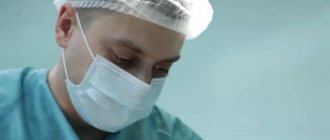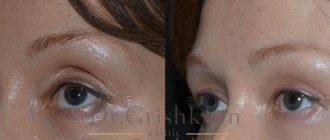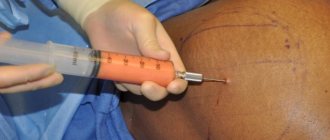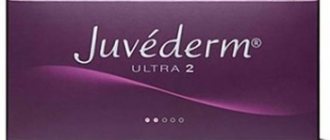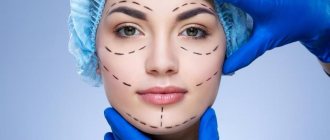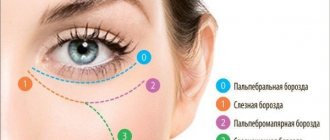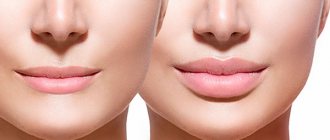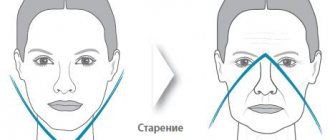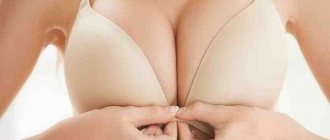Every woman has self-confidence, knowing that she always looks young and fit. But time is merciless, sooner or later everyone begins to grow old. For some, this process begins earlier and more intensely, for others - later and more slowly.
You can improve your appearance not only through expensive plastic surgery. In cosmetic surgery, several minimally invasive methods have recently been developed to help correct blemishes on the face, one of which is lipofilling
What is lipofilling?
This is a procedure that fills and shapes a specific area of the body using fatty tissue. This technique can replace implants or chemical fillers. In this case, fat cells can be taken from the thighs, abdomen or buttocks.
The procedure is performed under local anesthesia and lasts no more than three hours. General anesthesia is used for people with increased pain sensitivity or in case of extensive correction. Most often it is used in cases where it is necessary to fill folds on the face, eliminate wrinkles or sebaceous depressions. Surgeons, in some clinics, offer patients breast or hip augmentation using fat grafting.
Fat grafting is used to recontour the lips and lift drooping eyelids. This method guarantees maximum security. It is possible to use patient or donor fat, but then the cost of the method will increase significantly.
Lipofilling
The body's fat cells fill the soft tissues , merging with the surrounding elements. Over time, in some areas of the face, these cells move to other places, causing wrinkles to appear.
Fat transfer is based on the transfer of fat cells from one part of the body to another. For the procedure, you must have excess fat. Most often, the material is collected from the lateral surface of the thighs or from the abdominal area.
The technology is used in the following cases:
- Correction of the shape of the nose, cheekbones, cheeks, lips.
- Alignment of asymmetry.
- Elimination of folds, nasolacrimal grooves, deep wrinkles and sagging contours.
The probability of a positive result is 50% . This low rate is due to the fact that fat cell transplantation has not been fully studied. Despite the fact that during the operation the natural fat of the patient himself is taken, there is a risk that the material will not take root at all or partially. The injected cells will have to be removed.
Advantages of the technology:
- No risk of an allergic reaction.
- Cell compatibility.
- The result is permanent if the procedure is carried out well.
- Versatility - lipofilling is also used to correct the hips and buttocks.
- Possibility of introducing additional volume.
Advantages and disadvantages
The advantages of lipofilling of nasolabial folds include:
- A quick process of smoothing wrinkles in the nasolabial area.
- The appearance becomes younger and fresher.
- Minimal likelihood of an allergic reaction and complications.
- A more affordable method compared to Botox, other injections and implantations.
- In addition to improving and rejuvenating your appearance, lipofilling is a minimally invasive therapy and there are no side effects after it.
- Reduces scars and makes the skin better and more elastic.
Flaws:
- In the first days after the procedure, swelling and bruising may appear at the puncture sites.
- Taking baths, visiting saunas and steam baths is prohibited for 30 days after surgery.
- The final result can be seen only after a month, since the implanted tissue needs to take root.
- If fat is applied unevenly, bumps and asymmetry may appear on the face.
- Possibility of infectious infection.
- Postoperative pain syndrome.
Fillers
These drugs are dermal fillers that can:
- Reduce the depth of nasolabial folds and wrinkles.
- Add additional volume to certain facial areas (cheekbones, lips, cheeks).
The basis of fillers can be calcium, polylactic acid or collagen. Also, some procedures are performed using hyaluronic acid injections.
Advantages of introducing fillers:
- There is virtually no risk of complications.
- Internal tissues are not injured.
- The procedure goes quickly.
- Hyaluronic acid has a rejuvenating effect.
- It is possible to remove the drug without visible consequences.
- The composition does not linger in the body, absorption and removal occur quickly and without complications.
- The general condition of facial skin improves.
Stages of implementation
The fat grafting process begins with assessing the person's overall health and selecting the area for fat extraction. Usually the sampling is done from the thighs or abdomen. The manipulation is performed with a special syringe with an atraumatic cannula through small 5mm incisions.
Thanks to this, scars do not remain and bleeding does not start. Then the fat cells are separated into toxins, wastes, and fats using a centrifuge. The already purified fat is injected in small layers into the desired location on the face. If everything is injected at once, this will lead to necrosis and tissue rejection.
For this, very thin needles are used that do not leave marks. It will be easier for cells to take root in a new location, since the surface of the lipocytes will be preserved. The skin will turn a little red and there will be some swelling, but it will go away after a while. Some cells will resolve, but over time blood capillaries will grow into the rest, and they will finally take root.
The duration of the procedure can be from 45 minutes to 3 hours. It all depends on the amount of fat that needs to be injected. The procedure is performed on an outpatient basis and many patients only need a few days to recover. If you plan to inject a large amount of fat, then you need to be prepared to spend 5 days in cosmetology.
Before and after the procedure
Lip lipofilling: is it worth doing?
At a certain stage in the development of cosmetology and plastic surgery, lip lipofilling has become quite a fashionable and popular procedure. Which can be explained by several factors. Surgical lip augmentation, in particular the introduction of silicone or collagen implants, gave an unsightly and unnatural effect. Non-biodegradable fillers, such as biopolymers and liquid silicone, in turn, gave a lot of side effects - they caused the formation of coarse fibrosis, migration of drugs into neighboring tissues, which led to their fibrosis in the future. At the same time, fillers based on hyaluronic acid were quite expensive and not very durable. Not everyone could afford to seek the help of a cosmetologist every 3 months to introduce a new portion of fillers and maintain the lasting effect of plump lips. Therefore, lip augmentation with your own fat (lipofilling) has become an alternative correction method, which began to enjoy popularity after some time.
Madina Bayramukova
Photo: press materials
Lipofilling undoubtedly gives a fairly lasting effect . The price of lipofilling does not depend on the volume. You can inject a large volume of your own fat at an affordable price. However, this method has a lot of disadvantages compared to the same lip augmentation using fillers based on hyaluronic acid. In my opinion, lipofilling is not the procedure of choice for correcting this area for the following reasons.
Firstly , fat sampling itself is a surgical procedure that should not be used too often.
Secondly , the collected fat must be processed so that it becomes sufficiently homogeneous, but at the same time so that the fat cells do not lose their viability.
Thirdly , fat is injected into any area with a reserve, since it is impossible to predict in advance how much fat will take root. Because this process is individual: for some, 80% of the fat survives, for others, only 20%, and for others, nothing at all. Roughly speaking, either 1 ml of fat out of 10 or 8 out of 10 can take root - it is impossible to predict exactly how this will happen. If excess fat has taken root, it cannot be removed. And if it is not enough, we will be forced to re-sample the fat and reinject it into the lips. At the same time, liposuction is a rather traumatic and technically difficult intervention. Swelling of the lips and even the face after lipofilling can last for about a month. And hematomas after the injection of own fat can be quite extensive and persist for a long time.
Today there are a huge number of fillers based on hyaluronic acid for lip augmentation.
Photo: Unsplash.com
Today, there are a huge number of fillers based on hyaluronic acid for lip augmentation, which have a fairly long biodegradation period. Each subsequent lip augmentation leads to densification of the patient’s own tissues, which prolongs the effect of lip augmentation with fillers. The procedure itself has become more accessible than 10 years ago. We can always assume with a greater degree of probability how much hyaluronic acid will be retained in the tissues and what volume we will get in the end. The procedure itself is outpatient and does not require rehabilitation. This is not only the best way to enlarge lips, but also absolutely safe. Additionally, acid-enlarged lips feel more pleasant and natural-looking, while fat-enlarged lips often end up looking lumpy, uneven, and too tight.
Recovery process
Since lipofilling is a minimally invasive method, recovery after it occurs almost unnoticeably. Some people go back to work within two or three days after the operation and begin to live in their usual rhythm. However, it is possible that unpleasant sensations may occur:
- Slight swelling and tension in the nasolabial triangle.
- The skin becomes less sensitive.
- The appearance of bruises and yellowness at the puncture site.
The above effects disappear within 7 days. And after three weeks there will be no traces or symptoms reminiscent of the procedure. The fat mass needs two months to take root, then the nasolabial folds will smooth out. After this, the effectiveness of lipofilling can be assessed.
In some patients, the skin structure improves, it becomes smooth and elastic. The result of this method lasts for a long period, only in rare cases not for long.
The difference between fillers and lipofilling of nasolabial folds
Fillers containing hyaluronic acid have many advantages. With their help, you can not only get rid of wrinkles, but also correct an asymmetrical face, add volume to your lips or cheekbones. They help speed up metabolism and stimulate rejuvenation processes. Due to their wide range, you can choose a filler for a specific part of the face.
Lipofilling was invented even before the advent of fillers, and has a number of disadvantages. During fat transfer, half of the cells die, so a repeat procedure may be necessary. However, it has one big advantage. Since lipofilling involves transplanting your own fat, it means that allergies or incompatibility are impossible. This is a good alternative for people who are intolerant to fillers.
Lipofilling as an alternative to contour plastic surgery
Injections of your own fat can restore youthful volume to a “sagging” (tired) face. In its rejuvenating properties it is superior to hyaluronic acid. But for the success of the manipulation, it is important to answer the questions: how much, where, how and what do we expect from this,
–
says plastic surgeon Vera Malakhovskaya.
What is lipofilling and why is it attractive?
I started thinking about lipofilling as an alternative to the beloved contouring with hyaluronic acid after a conversation with Tiina Orasmae-Meder. A cosmetologist, a well-known expert in matters of beauty, she knows how to explain even very complex things “on her fingers”. There is a well-known Newton's law, she said, according to which gravity is equal to mass times acceleration - F=ma. In our case, gravity is the same hated gravity that causes our features to blur over time. And mass is the weight of subcutaneous fat, which transforms into jowls and a double chin.
It’s no secret - the “heavier” and fuller the face, the faster it goes down. But the same gels give additional weight. And if you consider that volumetric plastic surgery is in fashion today - to increase the volume of the cheekbones, midface, etc., fillers are introduced in large volumes. And the most common types of aging of Russian women are tired and deformed, with large folds and a large amount of subcutaneous fat. (And here - alas! - I am no exception). It turns out that in the struggle for a youthful face, we simultaneously aggravate the manifestations of gravity?
What’s attractive about lipofilling is that fat is much lighter than fillers. And, therefore, it does not weigh down the tissue and provokes ptosis less. Own, “native” material is not rejected and does not cause allergic reactions. Moreover, in the injection area the skin also rejuvenates - this is due to the mesenchymal stem cells contained in the adipose tissue, which trigger the rejuvenation processes. At the same time, we can get rid of fat traps and make the figure more attractive. Unfortunately, there is also the other side of the coin. On the forums, patients complain that they were disappointed with the promised result - the fat took root in small quantities or did not take root at all (most often in the area of the nasolabial folds), unevenness appeared during resorption, and “lumps” formed under the skin. And this, I must admit, is alarming.
2 reasons for disappointment with lipofilling
Vera Malakhovskaya has been practicing lipofilling for more than 10 years and explains this disappointment for two reasons.
- The first reason
is failure to comply with the details of the fat transfer technique. “The history of autologous fat grafting is very long,” she says. Fat grafting has been used for over 100 years. Naturally, during this time, significant experience has been accumulated and important conclusions have been made, and the technical aspects of fat engraftment have been worked out. However, in recent years, due to the growing popularity of aesthetic medicine, new specialists are constantly joining our ranks. Their failure to follow even small details at every stage leads to disappointment with the method. When performing lipofilling, it is very important to consider the volume of the corrected area: how much adipose tissue can be added so that it takes root. If too much fat is injected into an area of small volume, the tissue will take root along the periphery, and fibrosis may form inside and subsequently form calcification - something like a small stone. Therefore, when correcting large areas, lipofilling in two and sometimes three stages is inevitable to obtain the desired result.
An equally important aspect is the correct choice of the donor area: the structure of adipose tissue is not the same everywhere, in some places there are more adipocytes, in others there are fewer, in some places the adipose tissue is changed, characterized by fibrosis. To harvest, you have to make more passes, and this leads to trauma to the fat graft. Naturally, it will be less viable. Proper processing of adipose tissue and the injection process itself are very important: layer-by-layer, fractional distribution.
- The second reason
is misunderstanding between the doctor and the patient. The doctor must understand what the patient wants. And the patient, in turn, soberly assesses the capabilities of the method. “Today, patient concerns and discussions about effectiveness focus on engraftment rates. What percentage of fat will survive – 50, 60, 70? At the beginning of my practice, these numbers also worried me very much. But today I understand that they are not so important. Moreover, when someone uses specific numbers and refers to statistics for advertising purposes, I remember the joke of one famous English researcher: there are three types of lies - lies, blatant lies and statistics. Yes, resorption of adipose tissue occurs, and we cannot calculate it. In some areas (due to their characteristics), fat takes root better, in others - worse. And the patient must be told about this honestly. But focusing only on the engraftment of adipose tissue is wrong. Large volumes are important in reconstructive surgery. With age-related changes, we are talking not only about volumes, but also about regeneration. From this point of view, lipofilling gives an excellent effect - the rejuvenating potential of adipose tissue is greater than that of hyaluronic acid.
In addition, patients often evaluate the result against the background of postoperative swelling, mistaking the disappearance of swelling for the loss of transplanted fat. We can talk about the result after 3 months, when the process of adaptation of adipose tissue in the injection zone is completed.”
Advantages of lipofilling and possible complications after the procedure
Let’s figure out what aesthetic results you can expect and why when correcting different areas of the face. And what pitfalls (complications) exist here.
- Mid-face area (correction of cheekbones, cheeks)
The most fertile area for the use of lipofilling is that the injected adipose tissue takes root very well. This is due to the initial large amount of fatty tissue. Although many adipocytes die during transplantation, they send an impulse to the founders of adipose tissue - preadipocytes. And they begin to actively produce new fat cells, ensuring the constancy of the resulting volume.
Underwater rocks. At the same time, it is important not to forget that voluminous, heavy faces are more susceptible to ptosis. Although fat is lighter than gels, the tissue still becomes heavier. Therefore, the main thing is not to overdo it.
- Lips
Due to the presence of regenerative factors in adipose tissue, the introduction of autologous fat under the skin of the upper and lower lips will significantly rejuvenate this area, prevent or smooth out “hormone-dependent” purse-string wrinkles.
Underwater rocks. Transplantation of adipose tissue under the mucous membrane of the red border of the upper and lower lips will not provide such an increase in volume and clarity of shape as fillers with hyaluronic acid. If this is exactly what you expect, you will be disappointed: initially, the shape and projection of the lips are not determined by the presence of fatty tissue in them; there is practically none there.
- Nasolabial folds
The expectations of doctors and patients to get the same effect here as from filling with fillers with hyaluronic acid are not always justified. This is due to the anatomical features of this area. Active muscle work does not allow fat cells to take root. Age-related resorption of bone tissue in the upper jaw area contributes to the deepening of the nasolabial fold.
Underwater rocks. When talking about complications in the area around the mouth, we are more often faced with unjustified expectations of patients. It is in the area of retraction that more adipose tissue must be injected, but physiologically the engraftment of this volume is impossible.
- Eyelids
With age, the loss of fatty tissue under the orbicularis oculi muscle leads to drooping of the upper eyelids, in particular drooping of the eyebrows, and the appearance of furrows under the eyelids. Modern trends in aesthetic surgery provide for the correction of these changes simultaneously with blepharoplasty, and in some cases instead of it.
The injection of autologous fat gives a good rejuvenating effect - the eyebrows and upper eyelid are raised, the area under the lower eyelid and the tear trough are leveled.
Underwater rocks. This area is the most difficult to correct using lipofilling. Excessive or superficial injection of fat grafts can cause the development of fibrosis and, as a result, the appearance of unevenness, which is very noticeable on thin skin. It is very difficult to correct this complication. If too much fat is injected into the periorbital area, the eyes appear smaller. Overcorrection of the infraorbital region subsequently leads to a deepening of the nasolabial fold.
- Lower face area
Most often, in this area, adipose tissue is used to correct labio-mental folds, improve the line of the lower jaw, increase the projection of the chin and the angles of the lower jaw.
Underwater rocks. Unfortunately, autologous fat cannot resist the gravitational drooping of the cheeks, in which case its potential is lower than that of some fillers, such as Restylane. A single injection into areas that have lost volume between the cheek and chin does not always bring the desired projection. In the lower area of the face the rule does not apply: the more, the better. Excessive engraftment of adipose tissue can lead to its weighting or increased ptosis.
Cell technologies
Another important way to improve fat grafting is to improve the quality of the implant itself. Cellular technologies are used today for this purpose. Almost all clinics practicing lipofilling use PRP therapy - adding platelet-rich plasma to adipose tissue. According to statistics, it increases engraftment by about 15%. And in general, it is very useful in the fight against age-related changes.
The second “cellular” direction is the use of stromal-vascular cell fraction isolated from the same adipose tissue. According to researchers, engraftment increases by 25%. But it has not yet become widespread. The American technology “Satory” and the “Cellution” device - in one step it is possible to isolate the stromal-vascular cell fraction, purify adipose tissue using physiological solution, enrich it with stem cells and immediately perform autotransplantation - too expensive, labor-intensive, require a large number Supplies. Anesthesia and work require twice as much time as with conventional lipofilling. However, one can hope that this is only for now. After all, over time, all the most expensive technologies become cheaper. New discoveries are being made. Perhaps some of them will make auto fat an ideal filler!
Contraindications and indications
No ideal cosmetic procedure or plastic surgery has yet been invented. Lipofilling has its own characteristics:
- Women with an athletic build may not have enough fat cells to perform this method.
- If the surgeon is not experienced, there is a possibility that he will inject the fat unevenly, and then asymmetry of the nasolabial folds will be noticeable on the face. It is important to choose an experienced and qualified physician in advance.
- Due to the destruction of a certain amount of fat by the immune system, an excess amount of material is initially introduced. Therefore, at first after the operation it will seem that the face is in a swollen state.
- In many cases, the result of lipofilling remains throughout life, but there are cases when all the fat is absorbed after two or three months. The reason for this can only be the individual characteristics of metabolism or the patient’s immunity.
Before the procedure begins, the patient is prescribed a series of tests to help determine contraindications to the operation. Lipofilling is not performed:
- Pregnancy and lactation period.
- Severe chronic diseases.
- Acute infectious diseases.
- Disease of the skin of the face or at the site of fat collection.
Indications include:
- The appearance of age-related folds in the nasolabial triangle.
- Acquired defects in the nasolabial folds.
- Hereditary predisposition to early facial wrinkles.
- Wrinkles arranged asymmetrically due to characteristic features or certain diseases.
Review
Olga At the age of 35, I decided to put my face in order, started going to a cosmetologist and finally decided to undergo lipofilling of the nasolabial folds. I was pleasantly pleased with the result. The procedure is almost painless, there was slight discomfort only at the beginning, then the anesthesia took effect and there were no sensations. Afterwards a small hematoma appeared, but the doctor assured that it would go away soon. And so it happened three days later. I had lipofilling done six months ago, the effect still lasts. I was satisfied with everything.
Contraindications to the procedure
Before visiting a professional cosmetology office, be sure to consult with your doctor. You may have contraindications:
- severe somatic diseases;
- the presence of dermatological defects in the area of nasolabial folds;
- herpes or other acute viral and infectious diseases;
- blood clotting disorder;
- During pregnancy and breastfeeding;
- epilepsy and mental illness;
- tendency to form colloidal scars.
We have listed only the main contraindications. Also, this technique may be incompatible with taking certain medications or individual characteristics of the body.
From this article you learned what fillers are and how they are used to correct nasolabial folds. The results before and after the procedure in the photos above indicate the high effectiveness of this technique. In conclusion, we invite you to watch a video in which a cosmetologist will talk about fillers, their types, advantages and disadvantages. This video will definitely help you make the right choice.

